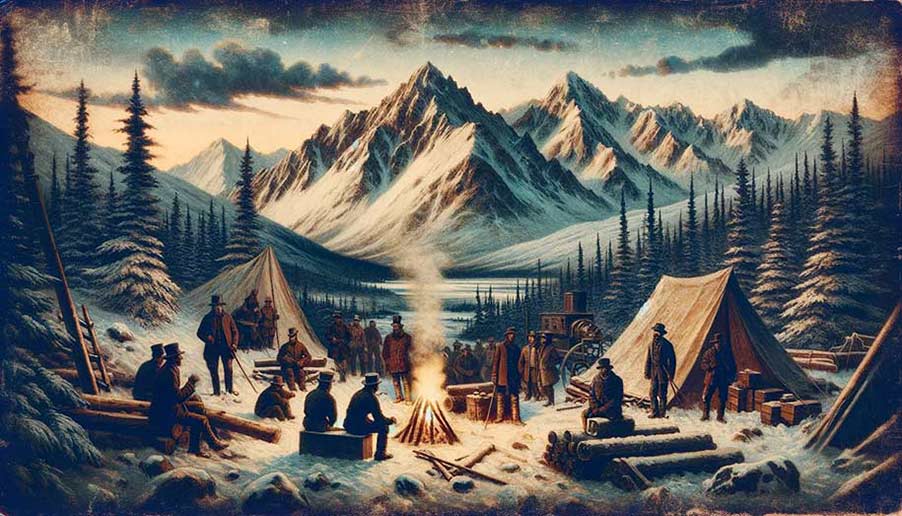Home / Blogs / What Does “Klondike” Mean In Klondike Solitaire?
What Does “Klondike” Mean In Klondike Solitaire?
By Brad - 05/26/2024
Klondike is undeniably the most popular style of solitaire out there. With a basic setup – seven tableau columns and a stockpile – pretty much anyone can pick up the game and learn it in a few minutes.
But what many aren’t as familiar with are the origins of solitaire’s many names. Spider, Freecell, Pyramid, and Klondike each have their own history, style of play, and passionate followings. So where did these names come from, and what does the "Klondike" in Klondike Solitaire actually mean?
A Trip Back To The Gold Rush
To get an idea of how Klondike Solitaire got its name, we need to hop in our card game time machine and go back a century or two.

Wild North America of the late 1800s was a simpler (although wilder) time, and one thing was on pretty much everyone’s mind: gold. And while you may think of the western United States as the peak gold rush destination, another spot was also high on the list – Yukon, Canada.
It was in an area known as Klondike that prospectors struck gold in 1896. Suddenly, travelers from across the world began the long, harsh journey to the Canadian wilderness. Cold nights, feet of snow, and an unforgiving landscape were just a few of the obstacles that stood between hopeful gold seekers and their own stash of fortune.
So, imagine the long days and nights traveling to the Yukon. Eventually, the appeal of the Canadian wilderness would wear off, and you’d need something to pass the time and keep your mind sharp. What better way than a game of cards?
Prospectors and miners put down their pickaxes and taught one another this fun new game of stacking cards by suit. They called it “Klondike” (creative, right?) and as the popularity grew, Klondike Solitaire was born.
How Did Solitaire End Up in Klondike?
So why solitaire and not some other card game? There are varying views on why this particular card game struck its own kind of gold in Canada, but one thought relates to Klondike Solitaire’s past as a game known as “Patience.”
Originating in Europe in the 1700s, Patience sees its first mention in books recalling its solitary nature – a one-person game that required little time to learn but plenty of slow, methodical sifting and sorting.
Fast forward to the late 1800s, and lonely prospectors on the hunt for gold could pull out a deck of cards, play a game, and pass the time while they traveled or waited on word of the next hint of gold. It was the perfect way to keep their mind occupied in what could be a long, boring existence that required… well, patience!
Sifting and Sorting
Interestingly, Klondike Solitaire itself has a metaphorical connection to gold prospecting that might help explain the game catching on so fast. Just as gold miners would spend hours shifting sediment with a sieve in hopes of finding that perfect nugget, Klondike Solitaire has players sifting through a stock stack of shuffled cards in search of the next play.
As players move through their deck, they must watch closely as each card is turned – searching for the right combination of stacking, sorting, and discarding that will ultimately lead them to clearing the board. And when those coveted aces appear, it can feel almost like striking gold itself!
Naturally, you can see how Klondike Solitaire started to scratch that same itch the prospectors and miners felt as they were looking for their own “ace” in the ground. (And for many, getting good at Solitaire was about the only success they’d have!)
Klondike Solitaire Today

We’ve come a long way since those days of searching for gold in the ground, and the popularity of Solitaire is still high. Though the ability to pick up a deck of cards and sort them into a Klondike Solitaire setup is pretty easy, we can thank the rise of the desktop computer for Klondike’s transition from niche game to cultural staple.
The release of the Windows 3.0 operating system by Microsoft back in 1990 saw Solitaire come standard in the ubiquitous “Games” tab. Suddenly, anyone with access to a computer could load up a game and play. And who can forget that feeling when you’d click that last card to the top of the pile and see the cascading, full-screen card effect?
It’s no virtual reality immersive experience, but we’d be lying if we said it didn’t feel close to striking gold!